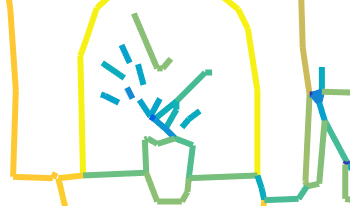References
1BainbridgeW. A.KwokW. Y.BakerC. I.2021Disrupted object-scene semantics boost scene recall but diminish object recall in drawings from memoryMem. Cogn.49156815821568–8210.3758/s13421-021-01180-3
2BainbridgeW. A.PounderZ.EardleyA. F.BakerC. I.2021Quantifying Aphantasia through drawing: Those without visual imagery show deficits in object but not spatial memoryCortex135159172159–7210.1016/j.cortex.2020.11.014
3CoppolaD.PurvesH. R.McCoyA. N.PurvesD.1998The distribution of oriented contours in the real worldProc. Natl. Acad. Sci. USA95400240064002–610.1073/pnas.95.7.4002
4DakinC. J.RosenbergA.2018Gravity estimation and verticality perceptionHandb. Clin. Neurol.159435943–5910.1016/B978-0-444-63916-5.00003-3
5DanceC. J.WardJ.SimnerJ.2021What is the link between mental imagery and sensory sensitivity? Insights from aphantasiaPerception50757782757–8210.1177/03010066211042186
6DanceC. J.IpserA.SimnerJ.2022The prevalence of aphantasia (imagery weakness) in the general populationConsciousness Cogn.9710324310.1016/j.concog.2021.103243
7DamianoC.GayenP.RezanejadM.BanerjeeA.BanikG.PatnaikP.WagemansJ.WaltherD. B.2023Anger is red, sadness is blue: Emotion depictions in abstract visual art by artists and non-artistsJ. Vis.23110.1167/jov.23.4.1
8DawesA. J.KeoghR.AndrillonT.PearsonJ.2020A cognitive profile of multi-sensory imagery, memory and dreaming in aphantasiaSci. Rep.101002210.1038/s41598-020-65705-7
9DijkstraN.BoschS. E.van GervenM. A.2017Vividness of visual imagery depends on the neural overlap with perception in visual areasJ. Neurosci. the Official J. Soc. Neurosci.37136713731367–7310.1523/JNEUROSCI.3022-16.2016
10DonderiD. C.2006Visual complexity: A reviewPsychol. Bull.1327310.1037/0033-2909.132.1.73
11FanJ. E.BainbridgeW. A.ChamberlainR.WammesJ. D.2023Drawing as a versatile cognitive toolNat. Rev. Psychol.2556568556–6810.1038/s44159-023-00212-w
12FieldD. J.BradyN.1997Visual sensitivity, blur and the sources of variability in the amplitude spectra of natural scenesVis. Res.37336733833367–8310.1016/S0042-6989(97)00181-8
13GuzmanA.
14HertzmannA.2020Why Do Line Drawings Work? A Realism HypothesisPerception49439451439–5110.1177/0301006620908207
15JacobsC.SchwarzkopfD. S.SilvantoJ.2018Visual working memory performance in aphantasiaCortex; A J. Devoted Study Nervous Syst. Behav.105617361–7310.1016/j.cortex.2017.10.014
16
17KayL.KeoghR.AndrillonT.PearsonJ.2022The pupillary light response as a physiological index of aphantasia, sensory and phenomenological imagery strengtheLife11e7248410.7554/eLife.72484
18KeoghR.PearsonJ.2018The blind mind: No sensory visual imagery in aphantasiaCortex; A J. Devoted Study Nervous Syst. Behav.105536053–6010.1016/j.cortex.2017.10.012
19KeoghR.BergmannJ.PearsonJ.2020Cortical excitability controls the strength of mental imageryeLife9e5023210.7554/eLife.50232
20KeoghR.WickenM.PearsonJ.2021Visual working memory in aphantasia: Retained accuracy and capacity with a different strategyCortex; A J. Devoted Study Nervous Syst. Behav.143237253237–5310.1016/j.cortex.2021.07.012
21MarksD. F.1973Visual imagery differences in the recall of picturesBr. J. Psychol.64172417–2410.1111/j.2044-8295.1973.tb01322.x
22MarksD. F.1995New directions for mental imagery researchJ. Mental Imagery19153167153–67
23PounderZ.JacobJ.EvansS.LovedayC.EardleyA.SilvantoJ.2022Only minimal differences between individuals with congenital aphantasia and those with typical imagery on neuropsychological tasks that involve imageryCortex; A J. Devoted Study Nervous Syst. Behav.148180192180–9210.1016/j.cortex.2021.12.010
24RudermanD. L.1997Origins of scaling in natural imagesVis. Res.37338533983385–9810.1016/S0042-6989(97)00008-4
25SayimB.CavanaghP.2011What line drawings reveal about the visual brainFront. Hum. Neurosci.511810.3389/fnhum.2011.00118
26WaltherD. B.FarzanfarD.HanS.RezanejadM.2023The mid-level vision toolbox for computing structural properties of real-world imagesFront. Psychol.141322
27ZemanA. Z.Della SalaS.TorrensL. A.GountounaV. E.McGonigleD. J.LogieR. H.2010Loss of imagery phenomenology with intact visuo-spatial task performance: a case of ‘blind imagination’Neuropsychologia48145155145–5510.1016/j.neuropsychologia.2009.08.024
28ZemanA.DewarM.SalaS. D.2015Lives without imagery - Congenital aphantasiaCortex; A J. Devoted Study Nervous Syst. Behav.73378380378–8010.1016/j.cortex.2015.05.019
29ZetzscheC.2005Natural scene statistics and salient visual featuresNeurobiol. Attention37226232226–32

 Find this author on Google Scholar
Find this author on Google Scholar Find this author on PubMed
Find this author on PubMed